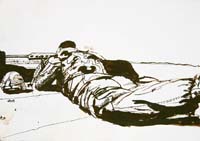 |
 |
 |
 |
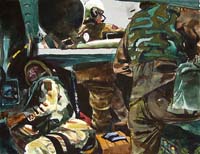 |
 |
 |
 |
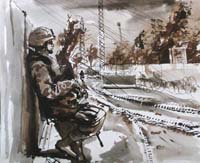 |
 |
 |
 |
 |
 |
 |
 |
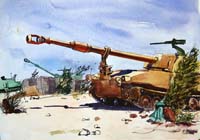 |
 |
 |
 |
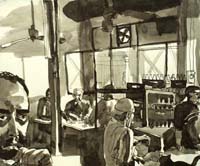 |
 |
 |
 |
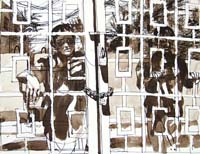 |
 |
 |
 |
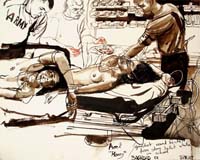 |
 |
 |
 |
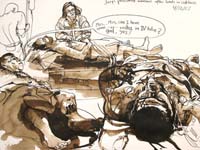 |
 |
 |
 |
|
|
|
||||||||||||
|
|
|
||||||||||||
|
|
|
By Paul X. Rutz Purdue University |
WEST LAFAYETTE, Ind.—Since coalition troops entered Baghdad in 2003, New York artist Steve Mumford has traveled there to document them, equipped with watercolors, India ink, and a digital camera. He files magazine-style stories from the field as a journalist (on ad-hoc press credentials from an online art site), yet he openly shuns the Associated Press guidelines for objective journalism, claiming that as an artist he is in a unique position to offer viewers a different kind of war image. However, like any journalist, Mumford said he sees his work primarily as “historical narrative” (personal communication, August 17, 2007). He writes photojournalistic captions to go with his from-the-field water colors, and he often uses his camera as an aid in making the paintings. For these and other reasons, while Mumford says he sees a palpable difference between his reasons for being in a war zone and those of photojournalists, he cannot avoid demonstrating a connection to photographers. Mumford’s alternating affinity with and direct critique of photography become evident when we compare the work he published online at Artnet.com, in a series titled Baghdad Journal, with famous images from past wars. This web essay presents Mumford’s Baghdad Journal as a case for class discussion, offering teachers of visual culture and rhetoric a set of examples for training students to see news pictures with inclusive, yet discerning, eyes. With his project, Mumford asks whether the status quo for making images of war in our time—especially snapshot photography—covers all the best practices available. Mumford’s project plants a seed of doubt about the authority of photographic images as the only reliable source of visual news evidence; a status left undisputed by most of our culture’s news consumers. I present a sample of his pictures with the hope that they can become productive occasions for training students in how to view different representational modes. In considering the idea of painting as journalism, I will provide an opportunity for students to use their own sensory experience to understand that a picture—even a photo—is not a package of indisputable evidence, and a photo in a war context is an incomplete artifact. Taken as a whole, this set of comparisons shows that war photographs are not simple truths. They are created and presented by people with certain opportunities, equipment, viewpoints, and agendas. As visual theorist W. J. T. Mitchell (2005) wrote, “pictures, including world pictures, have always been with us, and there is no getting beyond pictures . . . to a more authentic relationship with Being, with the Real, or with the World” (p. xiv). Sophisticated viewers have a sense of healthy doubt when presented with a picture that promises to bring a sense of “the Real” to them. While our discussion of war images must keep this in mind, Mitchell has reminded us that we must also remember, “Pictures want equal rights with language, not to be turned into language” (2005, p. 47). That is, pictures do not speak. They depict. As teachers we should cultivate a habit of discussing pictures in terms related to depicting, showing, and demonstrating, rather than saying, telling, and declaring. Clicking on one of the images above leads to a side-by-side comparison between an image of one of Mumford’s on-scene paintings and a photograph or other war picture. Some of these images show the same scene as depicted in the painting, and some show famous photos from past conflicts taken by Henri Cartier-Bresson, Robert Capa, Larry Burrows, and James Nachtwey, along with one etching by Civil War combat artist Winslow Homer. Each comparison begins with a quick discussion on the context around the two images and a “close viewing” of the pictures (not a “close reading,” since, as Mitchell reminds us, pictures are not texts). Next, each section succinctly presents a theoretical model with which we might more closely interrogate the comparison. Sometimes these models come in the form of a debate between more than one theorist in an effort to tease out questions for class discussion. Lastly, each section offers a recommendation for pedagogy, a suggested exercise or set of questions, to help students work their way through analysis of these pictures. Jean Baudrillard (1995) articulates important concerns about the assumptions we tend to make while watching the news in its various contemporary media forms. In his famous book The Gulf War Did Not Take Place, the poststructuralist left little doubt about his views on the news situation surrounding that 1991 war. |
Baudrillard took almost everyone to task—governments, news organizations, and citizens—as warmongers: “The real warmongers are those who live on the ideology of the veracity of this war, while the war itself wreaks its havoc at another level by trickery, hyperreality, simulacra, and by the entire mental strategy of deterrence which is played out in the facts and in the images” (1995, p. 67). He argues that faster information, and more of it, has not led to clearer understanding of what happened in the Gulf War. A glut of empty, unreliable “facts” in the news is nothing new. What is new in the digital age, for Baudrillard, is how good we have become at simulating a kind of reality on digital steroids that most people in the West have accepted as normal. That is, we believe our televisions, newspapers, and now the Internet show us as close as possible what is happening on the ground. All this hides the heavy censorship going on behind the scenes. Baudrillard’s work provides useful language for taking apart and re-examining our newsgathering habits—a very important contribution. But where do we go from there? Psychologist James Jerome Gibson (1979) forcefully argued against any notion that photographs capture an essence of the environment in which they were taken, writing, “We have been misled for too long by the fallacy that a picture is similar to what it depicts, a likeness, or an imitation of it. A picture supplies some of the information for what it depicts, but that does not imply that it is in projective correspondence with what it depicts” (p. 279). Like Baudrillard, Gibson wanted to shake up our belief in the authority of the news pictures we see; however, unlike Baudrillard, Gibson did not see pictures as empty “simulacra.” In fact, he saw a lot of value in them: “A picture is not like perceiving. Nevertheless, a picture is somehow more like perceiving an object, place, or person than is a verbal description” (1979, p. 280). Here Gibson played on the word “like,” using it first in a negative designation and then as an aid in developing a constructive, conciliatory statement. I believe we need both the negation of assumptions that through close inspection seem inaccurate and the proposition of new or overlooked methods to do so. This includes both the transfer of information about the war in Iraq and the theories we employ to discuss it. For that reason, this essay touches on several theoretical perspectives, including experimental psychology, along with semiotics, physiology, film theory, phenomenology, literary criticism, and photography. Merlin Donald (2001), another clinical psychologist, argued that psychology should borrow openly from literature studies and other humanities disciplines that try to understand the human mind. Where scholarly investigations overlap “we need to take an omnibus approach, as inclusive as possible” (Donald, 2001, p. 9). In other words, sometimes the best voices for teaching us better paths of inquiry are those speaking from outside our chosen scholarly fields. Science has its limit, Donald asserted: “We must respect that limit, wherever it may fall, in each generation, even though we may be impatient for a complete theory” (2001, p. 178). As science has its limits, so does our ability to represent events with pictures, even though we may be impatient for a complete picture of what goes on in a war zone. In the classroom, we can present Mumford’s project as an effort— frustrating and problematic—that has potential to address Baudrillard’s concerns about the glut of digital media by asking audiences to slow down and look again at a kind of war picture we are not used to seeing. While Mumford has shown large oil paintings about the Iraq war, those studio productions do not concern us here. I will focus on his quicker on-scene work, published alongside written articles he has filed periodically on Artnet. This essay does not present actual paintings, obviously, and these digital pictures must be viewed with that in mind. I am not arguing that the paintings themselves show the distinctions I illustrate. (Actually, a naked eye view of the original watercolors shows a host of other fascinating differences from photographs, and I encourage readers to view the various traveling exhibits of war art put on by universities and other institutions when the opportunity arises.) Instead, this essay begins with the premise that Mumford decided to draw every line and mix each color before he amplified those decisions by taking photos of his paintings and using Photoshop to adjust them. He then posted the pictures on the Internet along with descriptive captions as legitimate news reports from the battlefield. |
Acknowledgements Thank you to Lisa Banu, John Duvall, Rebecca Nicholson-Weir, Tony Russell, Winship Varner, and the anonymous readers at Kairos for their valuable contributions to this essay. |
|
|
Anderson, Joseph. (1996). The reality of illusion. Carbondale, IL: Southern Illinois University Press. Barthes, Roland. (1981). Camera lucida. (Richard Howard, Trans.). New York: Farrar, Straus and Giroux. Baudrillard, Jean. (1995). The Gulf War did not take place. (Paul Patton, Trans.). Bloomington, IN: Indiana University Press. Bazin, André. (2005). What is cinema? (Vol. 1). (Hugh Gray, Trans.). Berkeley, CA: University of California Press. Berger, John. (1972). Ways of seeing. London: Penguin. Berthoz, Alain. (2000). The brain’s sense of movement. (Giselle Weiss, Trans.). Cambridge, MA: Harvard University Press. Brothers, Caroline. (1997). War and photography: A cultural history. New York: Routledge. Burrows, Larry. (1966). South of the DMZ [Photograph]. Retrieved from http://www.digitaljournalist.org/issue0309/lm07.html Carroll, Noël. (1996). Theorizing the moving image. Cambridge: Cambridge University Press. Cartier-Bresson, Henri. (1933). Valencia, Spain [Photograph]. New York: Museum of Modern Art. Retrieved from http://www.moma.org/collection/object.php?object_id=56088 Cartier-Bresson, Henri. (1945). Dessau, Germany [Photograph]. New York: Metropolitan Museum of Art. Retrieved from http://www.metmuseum.org/Works_of_Art/collection_database/photographs/dessau_germany_henri_cartier_bresson/objectview.aspx?OID=190016994&collID=19&dd1=19 Cartier-Bresson, Henri. (1999/1952). The decisive moment. The mind’s eye: Writings on photography and photographers. New York: Aperture Foundation. Donald, Merlin. (2001). A mind so rare: The evolution of human consciousness. New York: Norton. Falling soldier. (2009, August 20). [Editorial]. The New York Times, p. A26. File:Capa, Death of a Loyalist Soldier.jpg. Wikipedia. Retrieved from http://en.wikipedia.org/wiki/File:Capa,_Death_of_a_Loyalist_Soldier.jpg Frei, Christian. (Producer/Director). (2001). War photographer [Motion picture]. Switzerland: Christian Frei Filmproductions.Gibson, James Jerome. (1979). The ecological approach to visual perception. Boston: Houghton Mifflin. Gopnik, Adam. (2005, October 31). Homer’s Wars: The simple epics of an American artist. The New Yorker, pp. 66-71. Homer, Winslow. (1862). The army of the Potomac: A sharp-shooter on picket duty [Etching]. National Gallery of Art, Washington, DC. Retrieved from http://www.flickr.com/photos/12328053@N04/1797024504 Kimmelman, Michael. (2004, August 4). Henri Cartier-Bresson, artist who used lens, dies at 95. The New York Times Online. Retrieved from http://www.nytimes.com/2004/08/04/arts/04CND-CARTIER.html?ex=1208750400%20&en=3c4d04819c0a320d&ei=5070 McCloud, Scott. (1994). Understanding comics: The invisible art. New York: Harper. Merleau-Ponty, Maurice. (1964). Primacy of perception. (William Cobb, Trans.). Evanston, IL: Northwestern University Press. Messaris, Paul. (1994). Visual literacy: Image, mind and reality. Boulder, CO: Westview. Metropolitan Museum of Art, New York. (n.d.). Description of Dessau, Germany. Photograph by Henri Cartier-Bresson. Retrieved from http://www.metmuseum.org/Works_of_Art/collection_database/photographs/dessau_germany_henri_cartier_bresson/objectview.aspx?OID=190016994&collID=19&dd1=19 Mitchell, W[illiam] J. T[homas]. (2005). What do pictures want? Chicago: University of Chicago Press. Mumford, Steve. (2003-07). Baghdad journal [Archives]. Artnet.com. Retrieved April 19, 2008, from http://www.artnet.com/Magazine/features/baghdadjournal.asp Mumford, Steve. (2003, August 18). An eyewitness artist's report from the Iraqi capital. Artnet.com Magazine Features - Baghdad journal. Artnet. Retrieved from http://www.artnet.com/Magazine/features/mumford/mumford8-19-03.asp Mumford, Steve. (2004). Abbas and Mohammed [Painting]. Baghdad Journal. Retrieved from http://www.artnet.com/Magazine/features/mumford/mumford8-16-3.asp Mumford, Steve. (2004). Paladins at FOB Gabe [Painting]. Retrieved from http://www.artnet.com/Magazine/features/mumford/mumford9-15-10.asp Mumford, Steve. (2004, July 29). Retaking Baqubah with the 1st ID. Artnet.com Magazine Features - Baghdad journal. Artnet. Retrieved from http://www.artnet.com/Magazine/features/mumford/mumford7-29-04.asp Mumford, Steve. (2003). Seedy teahouse [Painting]. Baghdad Journal. Retrieved from http://www.artnet.com/Magazine/features/mumford/mumford9-16-3.asp Mumford, Steve. (2004). Sgt. Cliat knocked out [Painting]. Baghdad Journal. Retrieved from http://www.artnet.com/Magazine/features/mumford/mumford7-29-7.asp Mumford, Steve. (2004). Snipers on Haifa Street [Painting]. Baghdad Journal. Retrieved from http://www.artnet.com/Magazine/features/mumford/mumford12-13-27.asp Mumford, Steve. (2004). Soldiers with suspects [Painting]. Baghdad Journal. Retrieved from http://www.artnet.com/Magazine/features/mumford/mumford7-12-7.asp Mumford, Steve. (2004, August 17). Stories from Baqubah. Artnet.com Magazine Features - Baghdad journal. Artnet. Retrieved from http://www.artnet.com/Magazine/features/mumford/mumford8-16-04.asp Mumford, Steve. (2004, August 22). Untitled photograph [Photograph]. Email from the photographer. Mumford, Steve. (2007). A young Iraqi girl with a bullet wound in her chest [Painting]. Baghdad Journal. Retrieved from http://www.artnet.com/magazineus/features/mumford/mumford10-2-07_detail.asp?picnum=31 Mumford, Steve. (2007). 'Mass-cas' event from a bomb in Iraqi Parliament [Painting]. Baghdad Journal. Retrieved from http://www.artnet.com/magazineus/features/mumford/mumford10-2-07_detail.asp?picnum=32 Nachtwey, James. (2007, March 28). Medics with a wounded marine in Iraq. The New York Times Online. Retrieved from http://www.nytimes.com/2007/03/28/arts/design/28nach.html Rother, Larry. (2009, August 17). New doubts raised over famous war photo. The New York Times Online. Retrieved from http://www.nytimes.com/2009/08/18/arts/design/18capa.html?_r=1&ref=arts Sontag, Susan. (2004). Regarding the pain of others. New York: Picador.
|
|